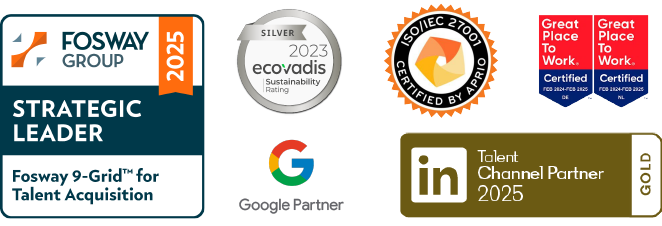Recruiting is no walk in the park. Finding good candidates, especially when you’re juggling a limited budget and time, can feel like a marathon. Long hiring times mean that valuable resources such as time, money, and energy are wasted.
But the good news is that we live in an era where data and digitalization are helping to speed up the entire recruitment process and improve quality. Investing in data-driven technologies and approaches that shorten the time to hire in multiple places not only has a positive impact on filling a single position but also has a significant impact on long-term recruiting strategy and business success.
Shortening recruitment time: the “time-to-hire” reveals optimization potential
The “time-to-hire” KPI describes the period between when a position becomes vacant and when a new employee is hired. Calculating the hiring time is like looking in the rear-view mirror, showing how efficient the entire recruiting process is and can positively influence future decisions. Regular monitoring of the key figure makes it transparent which steps take a particularly long time and where there is a need for optimization. Far too often, the time to hire is still underestimated. According to statista, the planned time-to-hire was 62 days on average last year. The actual time to hire, on the other hand, took over three months (93 days).
To avoid unpleasant surprises, it is worth taking a closer look at the various phases of the recruitment process. Placing job advertisements on media channels and job boards can often take far too much time and, above all, budget in terms of the duration of the recruitment process. This is due to the multitude of factors that need to be considered when planning, executing, and evaluating a job advertisement. Not only is the definition of the desired job profile and the creation of the job advertisement a time factor, but also the correct selection of media channels and job boards for the desired target group.
Not all job boards are created equally. Depending on the candidate profile being sought, a wide variety of media channels and job boards could be considered for the job advertisement. While graduates are more likely to be found on social media platforms, specialists from the STEM sector will mainly be found on niche portals. The selection of job boards & channels is gigantic today: from classic job boards, social media, direct career sites, forums, and apps to industry-specific niche sites, but all too often, media channels and job boards are still selected based on gut feeling or habit. This can lead to a shortage of applications, or a lack of suitable candidates. This situation forces existing employees to shoulder additional responsibilities, which can result in decreased productivity and increased workload stress. Additionally, the inability to fill key positions promptly may lead to a noticeable decline in sales and overall business performance. Perhaps most critically, it fosters an environment of employee frustration and dissatisfaction, which can have far-reaching effects on company morale and efficiency. These are just a few examples of the myriad challenges businesses face due to extended unfilled job positions.
The positive impact of data-driven recruiting on media selection and hiring time
Data-driven recruiting can help prevent serious consequences and answer important questions in the recruiting process, such as “Which channels have generated the most and best quality applications?” or “At which points along the candidate journey is the bounce rate particularly high?” With data-driven recruiting, recruiting decisions are made based on data. Data support is particularly helpful when advertising and analyzing the performance of job vacancies. Why? The performance data collected makes it clear what each individual channel contributes towards the success of the job advertisement, and which combination of media channels best reaches the desired target groups. This means that media channels that have not produced the desired results can be excluded from future job advertisements.
Fortunately, such data no longer has to be evaluated manually or requested individually from job board providers. Today, there are data-driven solutions that collect years of data and make precise recommendations about the channels that work best and, on top of that, take over the placement of job ads as well as performance monitoring of each channel used. In VONQ’s job marketing solution, all media channels and job boards (> 5000) are already contractually defined and can be booked directly via a shopping cart system. This not only saves time but also reduces the complexity and effort involved in job advertising and allows to invest the recruitment budget strategically and efficiently.
Conclusion – data-driven recruiting as a success factor for faster and more efficient staffing
Filling vacancies can be a real challenge, especially with a limited budget and time pressure. However, thanks to data-driven approaches and technologies, it is possible to a) speed up the entire recruitment process and b) increase the quality of applications. Investing in data-driven technologies that help reduce time-to-hire not only has short-term benefits but also has a long-term positive impact on recruiting strategy and hiring time. Data-driven recruiting is therefore the key to a faster, more efficient recruiting process that helps companies to target qualified candidates more effectively and reduce hiring time.
Discover the benefits of Data-Driven Recruiting with VONQ
We want to make finding the right candidates for your vacancies as easy as possible while increasing efficiency. To achieve this, we offer you a powerful solution that allows you to strategically place your job ads on > 5000 media channels and job boards.
Arrange a no-obligation demo with our experts to get to know our product, and find out more about how VONQ can help you with your recruiting challenges.
https://de.statista.com/statistik/daten/studie/420385/umfrage/vakanzzeit-von-sozialversicherungspflichtigen-arbeitsstellen-ausgewaehlter-engpassberufe-in-deutschland












